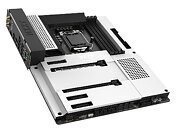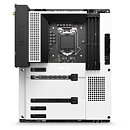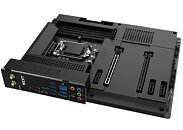Thursday, June 3rd 2021

NZXT Announces the N7 Z590 Motherboard
NZXT, a leading designer of computer hardware, software, and services for the PC gaming community, today announces the release of the NZXT N7 Z590 motherboard, their latest Intel-based ATX motherboard with both the features and seamless aesthetic that builders love.
The NZXT N7 Z590 brings the sleek design and simplified building experience to Intel's newest chipset, supporting Intel's 11th generation Rocket Lake CPUs, PCIe gen 4, and the latest wireless connectivity standards which includes Wi-Fi 6e and Bluetooth V5.1. Community feedback was the inspiration for adding additional rear I/O, as well as improved thermal performance with more power phases and layers to the printed circuit board.N7 Z590 Features
Intuitive Controls:
The N7 Z590 includes key features from our RGB and Fan Controller, allowing intuitive control of four RGB lighting channels and seven fan channels through CAM. Lighting accessories from all manufacturers are supported.
Stunning Craftsmanship
The metal cover is available in white or black for a seamless look that blends into the background of any NZXT H Series case for a clean aesthetic.
Building Made Easier
The N7 Z590 includes Wi-Fi 6e connectivity and utilizes all PCI express lanes available from the CPU and chipset. The N7's layout streamlines installation with an integrated rear I/O shield and optimally placed headers for easier setup.
For product specifications, visit this page.
The NZXT N7 Z590 brings the sleek design and simplified building experience to Intel's newest chipset, supporting Intel's 11th generation Rocket Lake CPUs, PCIe gen 4, and the latest wireless connectivity standards which includes Wi-Fi 6e and Bluetooth V5.1. Community feedback was the inspiration for adding additional rear I/O, as well as improved thermal performance with more power phases and layers to the printed circuit board.N7 Z590 Features
Intuitive Controls:
The N7 Z590 includes key features from our RGB and Fan Controller, allowing intuitive control of four RGB lighting channels and seven fan channels through CAM. Lighting accessories from all manufacturers are supported.
Stunning Craftsmanship
The metal cover is available in white or black for a seamless look that blends into the background of any NZXT H Series case for a clean aesthetic.
Building Made Easier
The N7 Z590 includes Wi-Fi 6e connectivity and utilizes all PCI express lanes available from the CPU and chipset. The N7's layout streamlines installation with an integrated rear I/O shield and optimally placed headers for easier setup.
- Designed with Intel Z590 Express Chipset
- Compatible with Intel 11th Generation Core i9, Core i7, Core i5, and Core i3 processors
- 12+2 DrMOS Power Phase Design
- Intel Wi-Fi 6E wireless connectivity and Bluetooth V5.1
- Two M.2 connectors for storage devices
- Multi-GPU support with AMD CrossFireX Technology
- Supports memory overclocking speeds of up to 4600 MHz and Intel XMP 2.0
- 8-channel high-definition audio
For product specifications, visit this page.





20 Comments on NZXT Announces the N7 Z590 Motherboard
EDIT: Sorry, the Z590 is a Steel Legend
that being said this mobo looks kind of ugly to me... I don't mind the dust shrouds for the entire mobo, Asus TUF series does it better though and is cheaper to boot.
After watching those videos I don't think I could ever give them my money.
But as it is, no, just no....
but hey, at least they skipped those stupido ps/2 & serial ports on the back, so there's that, hahahaha :)
They slap shrouds all over the board because they don't want you to see what's underneath, I bet. Because underneath all that suffocating crap is, well, a pretty standard-looking board.
That VRM heatsink design though. oooof. Was that designed by the guy in charge of the H1 case? All I can see there is "molten silicon".
The z490 PG Velocita, however, did kinda suck. I have a broken one. Has 3 of those tiny fans on it - one hidden inside the I/O shroud and two sandwiched behind the top VRM heatsink.
Yeah, I get it. most people use NVME as main drive and then add only 1-2 data grave's to it.... but there are still enough people having 4-5 drives which still run well and we'd love to keep...
Being that limited on a modern board in that price-range (where even boards in the age of 2500k cpu's had 2 sata6 and 4 sata3 ports already) is a bit .... strange for me.
And why are so expensive nowadays???
WORD 2: Shortages..
WORD 3: Scalpscum....
Face it, EVERYTHING is moar expensive now than before last march.... and if you think that prices are gonna go back down anytime soon, well then, I have some prime beachfront property you can buy for cheap....
p.s it's in north dakota, hehehehe :D
However, rising component costs, due to supply constraints, added to the scalping/bot bulk buying & reselling for way over MSRP, those are anutha story altogether.... :D